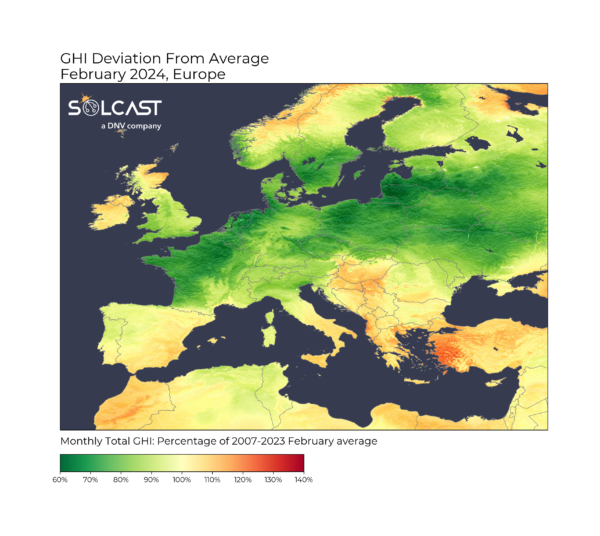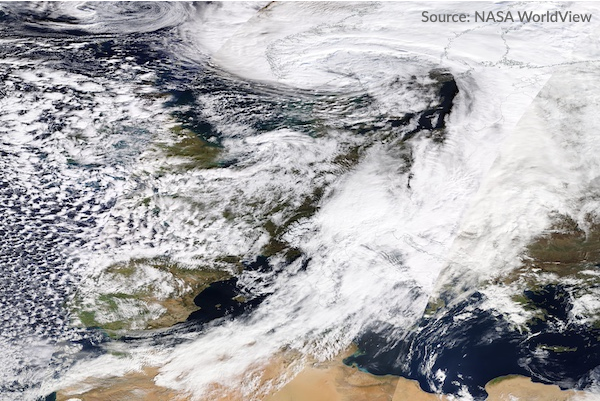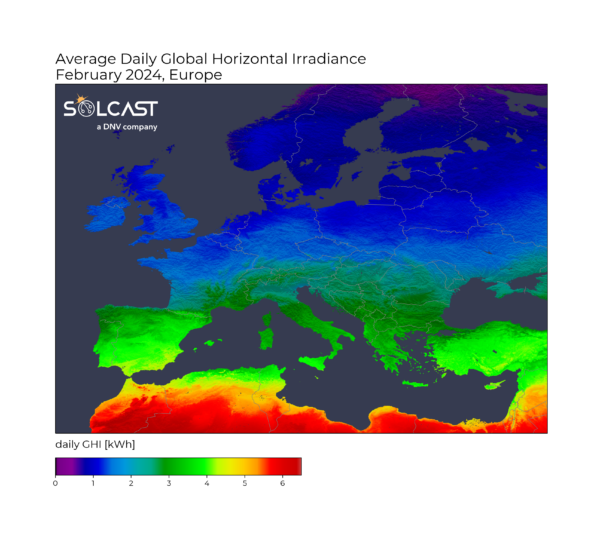In a new weekly update for pv magazine, Solcast, a DNV company, reports that irradiance and PV production was more than 15% below normal during February across most of Europe, due to thick clouds in moist westerly winds from the Atlantic.
March 15, 2024 Solcast
Irradiance and PV production was more than 15% below normal during February across most of Europe, according to analysis completed using the Solcast API. The production shortfalls were due to thick clouds in moist westerly winds from the Atlantic, penetrating more strongly and further east than usual for this time of year.
The large shortfalls in solar production compared to February normals spanned a vast area, across the UK (-13%), France (-19%), Belgium (-31%), Netherlands (-35%), and Germany (-17%). Shortfalls of similar magnitude were seen across Switzerland, Northern Italy, Austria, the Czech Republic, Slovakia, Poland, southern Sweden, the Baltic states and Ukraine. Some locations in France and Poland reached as low as 40% below normal irradiance.

The thicker-than-usual clouds were the result of a series of low pressure systems in the vicinity of Iceland, Norway and the UK. These low pressure systems drove moist westerly winds and clouds from the Atlantic deep across Europe north of the Alps.

With high winter-time precipitation, the solar production shortfalls could have been even worse due to snow soiling. Above-normal temperatures led to more rain than snow during February 2024.
Further south, conditions were closer to normal in more stable weather conditions across Portugal, Spain, Southern Italy, Greece, Turkey and the Balkans. Mean daily irradiation in these areas during February reached up to 4 kWh per day, with some areas receiving 120% normal irradiance. Ireland and Scotland, also received more irradiance than normal in February, but mostly due to the shorter days, this was still less than 1.5kWh per day.

Solcast produces these figures by tracking clouds and aerosols at 1-2km resolution globally, using satellite data and proprietary AI/ML algorithms. This data is used to drive irradiance models, enabling Solcast to calculate irradiance at high resolution, with typical bias of less than 2%, and also cloud-tracking forecasts. This data is used by more than 300 companies managing over 150GW of solar assets globally.
The views and opinions expressed in this article are the author’s own, and do not necessarily reflect those held by pv magazine.
This content is protected by copyright and may not be reused. If you want to cooperate with us and would like to reuse some of our content, please contact: [email protected].
>>> Read full article>>>
Copyright for syndicated content belongs to the linked Source : PV-Magazine – https://www.pv-magazine.com/2024/03/15/atlantic-blast-hits-european-solar-production/































